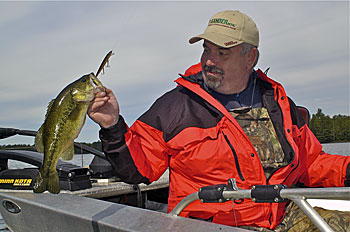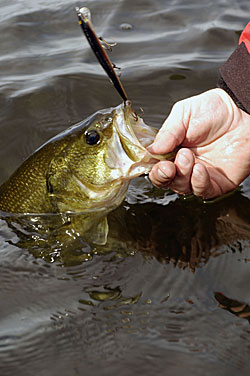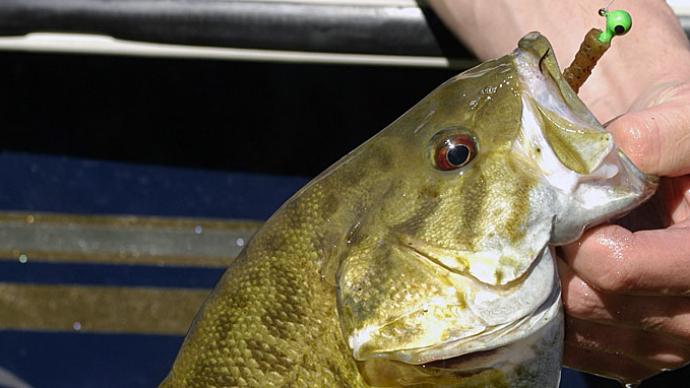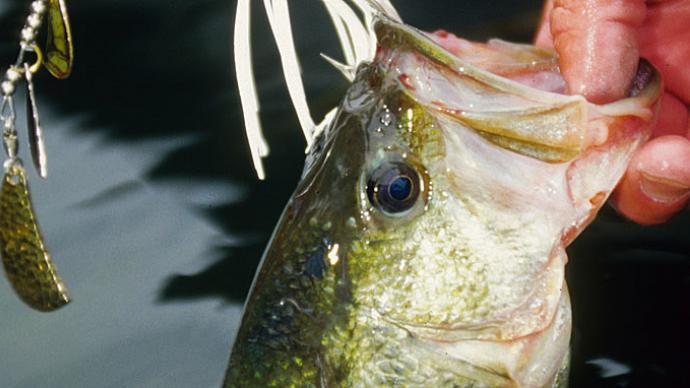
Michigan’s Upper Peninsula (UP) bass don’t get nearly the attention from bass anglers as they deserve, but there are signs that is changing. There is little doubt that the unrelenting barrage of bass shows broadcast on television has raised the curiosity level of anglers interested in giving UP bass a shot. Having a major B.A.S.S. tournament on Bays De Noc didn’t hurt either. Out-of-state bass fanatics are taking notice of UP’s bass fishing potential. Boat ramps are seeing increasing out-of-state trailers as word gets out about the UP’s varied and untapped bass fishing.
UP bass waters typically come in two general types – floodings, backwaters, and shallow impoundments that are largemouth havens and deep, clear, rocky lakes that are more conducive to producing smallmouth bass. For a diehard bass angler, it is finned nirvana.
Below is a sampling of UP waters that will get you started in your search.
Bay De Nocs
Smallmouth bass in Big and Little Bay De Nocs were not targeted much and are mainly caught by accident when walleye fishing or sought as a backup when the walleyes are not cooperating. More serious bass anglers are taking notice of the area's tremendous bass angling opportunities.
Smallmouth fanatic Joe Balog of Millennium Promotions Inc. has fished just about every major smallmouth venue in the Wolverine State and participated in several Bassmaster Elite tournaments on Bays De Noc. He’d be the first to tell you that fishing there is not like most other bass honey holes.
“There’s a big difference between the Bays De Noc and Lake St. Clair,” he offered. “For one thing, there are fewer fish per acre than in someplace like Lake St. Clair. There are tremendous areas of dead water. You can go days without seeing a smallmouth if you’re not in the right area.”
Balog said Bays De Noc's food sources are much more limited, so bass will go where the food is, even if that means 100 feet of water. “There are times of the year where bass are going to suspend over deep water shadowing pelagic schools of baitfish. When they’re doing that, they’re almost impossible to find. The obvious structure may not hold any fish then,” he said.
But in May, June, and July, Bay De Noc smallmouths are in very predictable places. They’re concentrated in the shallows to spawn.”
“You need to fish shallow,” said Balog. “There’s always a shallow population of bass. We’re talking in eight feet of water or less. Reeds hold a lot of fish. You must power fish with jerk baits, swim baits, spinner baits, and lipless crankbaits. You’ll catch many 3- to 4-pounders that way, but not many giants.”
For maps, lodging and tackle, contact Sall-Mar Resort at www.sallmarresort.com or call 906-553-4850.
Prickett Dam Backwaters
“There’s a lot of good bass fishing on this end of the UP,” claimed Western Lake Superior Management Unit Fisheries Supervisor George Madison. “There are so many good ones it’s hard to name just a few. You’ll have more gravel shoaled lakes from Marquette west and consequently more smallmouths.” But on the other hand, backwaters like Prickett Dam Backwaters, Shakey Lakes, and Gene’s Pond to the east offer ideal largemouth bass habitat. Smallmouths abound in the backwaters of the Menominee River.
One of those classic largemouth waters is Prickett Dam Backwaters. “Prickett Dam Backwaters has a lot of woody structure, standing timber, laydowns, and stumps that make it ideal largemouth habitat,” Madison said. “It’s just a fun place to fish.” Because it’s relatively shallow and filled with stumps, it’s not a place for high-powered bass boats and jets skis.
Because of the impoundment’s woody nature, it’s best to throw semi-weedless lures, like spinnerbaits, Slug-Gos, Texas-rigged worms, churn a buzz bait on the surface or risk contributing a bunch of tackle to the Fish Gods. There is a launch site on the west side of the impoundment.
Lake Independence

Lake Independence is famous as being home to the state record yellow perch, giving up massive pike to ice-anglers and producing walleyes consistently, but smallmouths? The lake is proof that Yoopers have largely ignored bass until recently.
“Last time we surveyed Lake Independence, we found a lot of smallmouths, and many of them were legal-sized fish,” Madison said. Look for jumbo smallies off the rocky west shoreline, near the north shore gravel bars that predominate there and contours along the eastern shoreline and the dam. Topwater lures can provide exciting action on calm mornings. Casting crankbaits parallel to the drop-offs or hopping a tube jig down the slope will interest smallmouths that will average 14 to 18 inches.
For information on bait shops and accommodation in the Marquette area, call the Marquette CVB at1-800-544-4321 / 906-228-7749.
Ottawa Lake
Lake Ottawa in Iron County is proof that there is more bass fishing interest in the UP. The 550-acre lake has catch-and-release regulations for bass, which seem to be working. The Iron County lake sees a fair amount of pressure from anglers looking to get their hands on a trophy smallmouth.
Ottawa Lake is extremely clear and deep, so look for smallmouth in the shallows relating to the old log cover installed by USFS long ago. The logs provide habitat and are home to the exotic rusty crayfish on which these bass thrive. The lake is an excellent place to sight-fish. Use polarized glasses and skirt the edges looking for spawning bass or logs. You can toss tubes, cast spinnerbaits, or twitch a jerk bait on the surface. An excellent location to try is on the lake's northeast corner, where a remnant rock pile off the township park attracts lunker bass. A mud flat on the opposite end of the lake can be good, too.
Lake Gogebic and Lac Vieux Desert
Madison mentioned two other lakes for bass that are not known as bass lakes per se are Lake Gogebic and Lac Vieux Desert. Both are located in Gogebic County. 4,300-acre Lac Vieux Desert is a famous muskie venue that Michigan shares with Wisconsin. It has a long history of producing giant smallmouth, often topping 5 pounds. Fishing is best in the spring before the weeds get too thick, but good bass can be caught throughout the season near Duck, Draper, and Near islands on the lake’s east side, along the south shoreline, and along the contours near the boat launch in Misery Bay on the north end of the lake. Most anglers concentrate on the walleye, muskie, and panfish the lake is famous for.
Most anglers targeting 12,800-acre Lake Gogebic are there for the walleye and jumbo perch. But George Madison said it’s a good bet if you’re interested in trophy smallies. Hundreds of fish shelters are the key to locating the biggest smallies that will scare the heck out of 6 pounds. The shelters are marked by red diamond signs on the shoreline and are generally in 10 to 15 feet of water, which is perfect for bass. Bounce crankbaits or tube jigs off the structures or cast minnow-tipped jigs.
Shakey Lakes
Few people have heard of the Shakey Lakes chain in southwestern Menominee County. The chain of lakes includes Resort, Long, Becker’s, Bass, East, and Baker’s lakes. They could all have been called Bass Lake. Formed by the Shakey River, the lakes provide outstanding habitats for wood ducks, ring-neck ducks, and largemouths. In the early fall, we were there for the ducks, but we ran into a group of anglers from Indiana who come up every year for the bass. Most years, they did better on the bass than we did on the ducks.
The chain has downed timber, stumps, lily pads, and weed beds that shout largemouth. There are secluded bays and coves where you probably won’t see another person all day. Largemouth bass up to 5 pounds are typical.
Northern Lake Michigan
Drive along the northern shore of Lake Michigan west of the Straits of Mackinaw on US Highway 2 and look out at the lake; you can’t help but think of smallmouth bass. On a map, you’ll see over a half dozen shoals and reefs, several points and coves, and places where more than a half dozen creeks and rivers enter the lake. Beaver Island, Hog Island, the Bays De Noc, Traverse Bay, and Waugoshance Point are smallmouth destinations. Why not the stretch of shoreline between the Mackinaw Bridge and Naubinway?
“I’m sure there are some scattered smallmouths along the Lake Michigan shoreline,” theorized Darren Kramer. “There may even be some pockets of fish, but the question is access and wind.” You must believe that reefs like Millecoquins, Fagan, Simmons, Pelkie, and Naubinway between Epoufette and Naubinway offer incredible smallmouth habitat. Pick the right day, and you might discover smallmouth nirvana.




